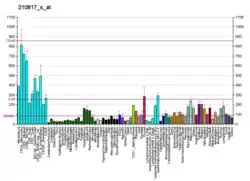| CALCOCO2 | |||||||||||||||||||||||||||||||||||||||||||||||||||
|---|---|---|---|---|---|---|---|---|---|---|---|---|---|---|---|---|---|---|---|---|---|---|---|---|---|---|---|---|---|---|---|---|---|---|---|---|---|---|---|---|---|---|---|---|---|---|---|---|---|---|---|
| |||||||||||||||||||||||||||||||||||||||||||||||||||
| Identifiers | |||||||||||||||||||||||||||||||||||||||||||||||||||
| Aliases | CALCOCO2, NDP52, calcium binding and coiled-coil domain 2 | ||||||||||||||||||||||||||||||||||||||||||||||||||
| External IDs | OMIM: 604587 HomoloGene: 31339 GeneCards: CALCOCO2 | ||||||||||||||||||||||||||||||||||||||||||||||||||
| |||||||||||||||||||||||||||||||||||||||||||||||||||
| |||||||||||||||||||||||||||||||||||||||||||||||||||
| |||||||||||||||||||||||||||||||||||||||||||||||||||
| |||||||||||||||||||||||||||||||||||||||||||||||||||
| Wikidata | |||||||||||||||||||||||||||||||||||||||||||||||||||
| |||||||||||||||||||||||||||||||||||||||||||||||||||
Calcium-binding and coiled-coil domain-containing protein 2 is a protein that in humans is encoded by the CALCOCO2 gene.[3][4]
The protein encoded by this gene is a subunit of nuclear domain 10 (ND10) bodies. ND10 bodies are nuclear domains appearing immunohistochemically as ten dots per nucleus. They are believed to be associated with the nuclear matrix on the basis of their resistance to nuclease digestion and salt extraction. ND10 proteins are removed from the nucleus by HSV-1 infection and may have a role in viral life cycles.[4]
CALCOCO2 is an autophagy receptor, and loss of CALCOCO2 in human beta cells has been linked to autophagy-mediated altered insulin granule homeostasis. Thus, mutations in CALCOCO2 have been linked to type 2 diabetes risk.[5]
References
- 1 2 3 GRCh38: Ensembl release 89: ENSG00000136436 - Ensembl, May 2017
- ↑ "Human PubMed Reference:". National Center for Biotechnology Information, U.S. National Library of Medicine.
- ↑ Korioth F, Gieffers C, Maul GG, Frey J (July 1995). "Molecular characterization of NDP52, a novel protein of the nuclear domain 10, which is redistributed upon virus infection and interferon treatment". The Journal of Cell Biology. 130 (1): 1–13. doi:10.1083/jcb.130.1.1. PMC 2120522. PMID 7540613.
- 1 2 "Entrez Gene: CALCOCO2 calcium binding and coiled-coil domain 2".
- ↑ Rottner AK, Ye Y, Navarro-Guerrero E, Rajesh V, Pollner A, Bevacqua RJ, et al. (December 2022). "A genome-wide CRISPR screen identifies CALCOCO2 as a regulator of beta cell function influencing type 2 diabetes risk". Nature Genetics. 55 (1): 54–65. doi:10.1038/s41588-022-01261-2. PMC 9839450. PMID 36543916.
Further reading
- Maruyama K, Sugano S (January 1994). "Oligo-capping: a simple method to replace the cap structure of eukaryotic mRNAs with oligoribonucleotides". Gene. 138 (1–2): 171–174. doi:10.1016/0378-1119(94)90802-8. PMID 8125298.
- Sternsdorf T, Jensen K, Züchner D, Will H (July 1997). "Cellular localization, expression, and structure of the nuclear dot protein 52". The Journal of Cell Biology. 138 (2): 435–448. doi:10.1083/jcb.138.2.435. PMC 2138200. PMID 9230084.
- Suzuki Y, Yoshitomo-Nakagawa K, Maruyama K, Suyama A, Sugano S (October 1997). "Construction and characterization of a full length-enriched and a 5'-end-enriched cDNA library". Gene. 200 (1–2): 149–156. doi:10.1016/S0378-1119(97)00411-3. PMID 9373149.
- Florin L, Schäfer F, Sotlar K, Streeck RE, Sapp M (March 2002). "Reorganization of nuclear domain 10 induced by papillomavirus capsid protein l2". Virology. 295 (1): 97–107. doi:10.1006/viro.2002.1360. PMID 12033769.
- Di Y, Li J, Zhang Y, He X, Lu H, Xu D, et al. (June 2003). "HCC-associated protein HCAP1, a variant of GEMIN4, interacts with zinc-finger proteins". Journal of Biochemistry. 133 (6): 713–718. doi:10.1093/jb/mvg091. PMID 12869526.
- Everett RD, Sourvinos G, Leiper C, Clements JB, Orr A (February 2004). "Formation of nuclear foci of the herpes simplex virus type 1 regulatory protein ICP4 at early times of infection: localization, dynamics, recruitment of ICP27, and evidence for the de novo induction of ND10-like complexes". Journal of Virology. 78 (4): 1903–1917. doi:10.1128/JVI.78.4.1903-1917.2004. PMC 369473. PMID 14747555.
- Colland F, Jacq X, Trouplin V, Mougin C, Groizeleau C, Hamburger A, et al. (July 2004). "Functional proteomics mapping of a human signaling pathway". Genome Research. 14 (7): 1324–1332. doi:10.1101/gr.2334104. PMC 442148. PMID 15231748.
- Rual JF, Venkatesan K, Hao T, Hirozane-Kishikawa T, Dricot A, Li N, et al. (October 2005). "Towards a proteome-scale map of the human protein-protein interaction network". Nature. 437 (7062): 1173–1178. Bibcode:2005Natur.437.1173R. doi:10.1038/nature04209. PMID 16189514. S2CID 4427026.
- Morriswood B, Ryzhakov G, Puri C, Arden SD, Roberts R, Dendrou C, et al. (August 2007). "T6BP and NDP52 are myosin VI binding partners with potential roles in cytokine signalling and cell adhesion". Journal of Cell Science. 120 (Pt 15): 2574–2585. doi:10.1242/jcs.007005. PMC 2621013. PMID 17635994.
External links
- CALCOCO2 human gene location in the UCSC Genome Browser.
- CALCOCO2 human gene details in the UCSC Genome Browser.


